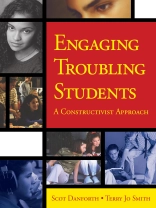‘Danforth and Smith have written an exceptional book on educating ′troubling′ students. It is a clear alternative to current books on educating children with emotional and behavioral disorders, most of which are based on behavioral theories. They offer practical guidance, well illustrated with stories from their own experiences on collaboration, working with families, conflict resolution, social support for students, providing a caring pedagogy, and teacher development.’
James L. Paul, Professor, Special Education
University of South Florida
Truly teaching ‘troubling’ students means connecting with them in ways that can last a lifetime!
Teachers are consistently faced with students who behave in disruptive or disrespectful ways. These ‘troubling’ students are frequently disengaged from both academics and the possibility of meaningful relationships with caring adults. How can teachers engage these students in instruction and learning as well as the development of trust and personal growth?
Engaging Troubling Students offers instructional and student support practices grounded in critical constructivism–engaging problematic students in the learning process and building strong relationships with them. These interactions and relationships can have a profound impact on their emotional well-being and learning. Danforth and Smith draw from many academic fields to build this comprehensive resource:
- History and roots of current issues and dilemmas
- Theoretical foundation of critical constructivism
- Teaching practices designed to foster the teacher-student relationship
- Specific programs addressing conflict, families, inclusive education, and more
Filled with rich narrative and directed to teachers working with troubling students each day, this insightful, practical guide will help lead you as you develop helpful, trusting relationships with them.
Cuprins
Acknowledgments
About the Authors
Introduction
Teaching as Relationship
About This Book
Outline of the Book
Part I: Conceptual and Historical Foundations
1. Examining Child and School Behaviors
2. Introducing Critical Constructivism
3. Creating a Participatory Classroom Community
Part II: The Pedagogies of Constructivism
4. Adopting a Caring Pedagogy
5. Working Together
6. Reflective Teaching
Part III: Programs and Practices
7. Using Conflict Resolution as Instruction
8. Implementing the KEYS Program for Students With E/BD
9. Working With Families
10. Considering Inclusive Education
11. Honoring and Developing Ourselves as Teachers
References
Index
Despre autor
Terry Jo Smith is an Associate Professor of Special Education at National Louis-University in Chicago. She has extensive experience teaching students labeled emotionally/behaviorally disordered in inner-city schools. She has an abiding interest in teacher research, particularly in relationship to the social, cultural and political dimensions of schooling and how these are enacted in school relationships and curriculum. She has worked with a group of teacher/researchers for several years, researching the impact of constructivist pedagogy in a broad range of educational settings. Currently, she is engaging in research at a school in a youth detention center where she is developing constructivist curriculum with teachers and students. Smith′s teaching, research and scholarship spring from a passionate commitment to social justice.












